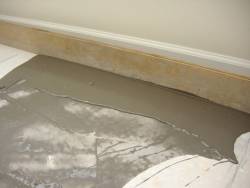Fix High and Low Spots in Subfloor
Dealing with bumps and depressions in your subfloor is your last chance to smooth things out (both figuratively and literally) before laying down the finish floor.
I like to talk a lot about the benefits of layering and how layering can save your butt (in other words, if you mess up this layer, there will be another, covering layer atop to cover up your mess). So, you really have to make this one count, because you’re at the next-to-last layer.
High Spots and Bumps in Subfloor
If you need to bring down your subfloor, you can try either a hand plane or a power sander. If you have a drum sander on hand, this can level out any bumps in the subfloor, but you need to have a steady hand to control this.
Actually, if you go overboard and gouge out some of the subfloor, it’s not the end of the world. The gouges can be filled in…or if small enough, the finish floor may be able to bridge them, as long as you’re installing solid wood or engineered wood flooring.
If your subfloor is of the solid wood variety (i.e., not plywood or OSB), you can single out a floorboard or two that are creating the bump, and which cannot be easily sanded or planed down, then you can pop them out and replace them.
Have a crawlspace or basement? Then you have access to the bottom of the floorboards.
It really doesn’t matter how ugly a job this is–you’re going to cover it up anyway.
Got plywood or OSB subfloor that is warped or bumpy and can’t be sanded down? Then either screw the thing out or pry it out and replace it.
Low Spots and Depressions in Subfloor

Some flooring, such as solid wood or engineered wood, can bridge small depressions. Any depression that is more than 3 or 4 inches wide is, in my opinion, too wide. It’s not the depth of the depression that matters; it’s the width.
Floor leveling compound is made for just such a thing. Spread it on, trowel it smooth. Guides often tell you to sand it smooth–but what’s the point? As long as it’s level, you can forgo the sanding.
When you have depression that are three or four feet in diameter or more, it’s the joists that are the problem. You need to get access to the bad joist(s) and replace or repair. Sometimes a joist will be bowed simply as a function of aging. This type of joist can receive wedges on top to bring the level up. While it’s probably fruitless to try to straighten out these warped joists, you can most certainly sister them and prevent them from warping any more.